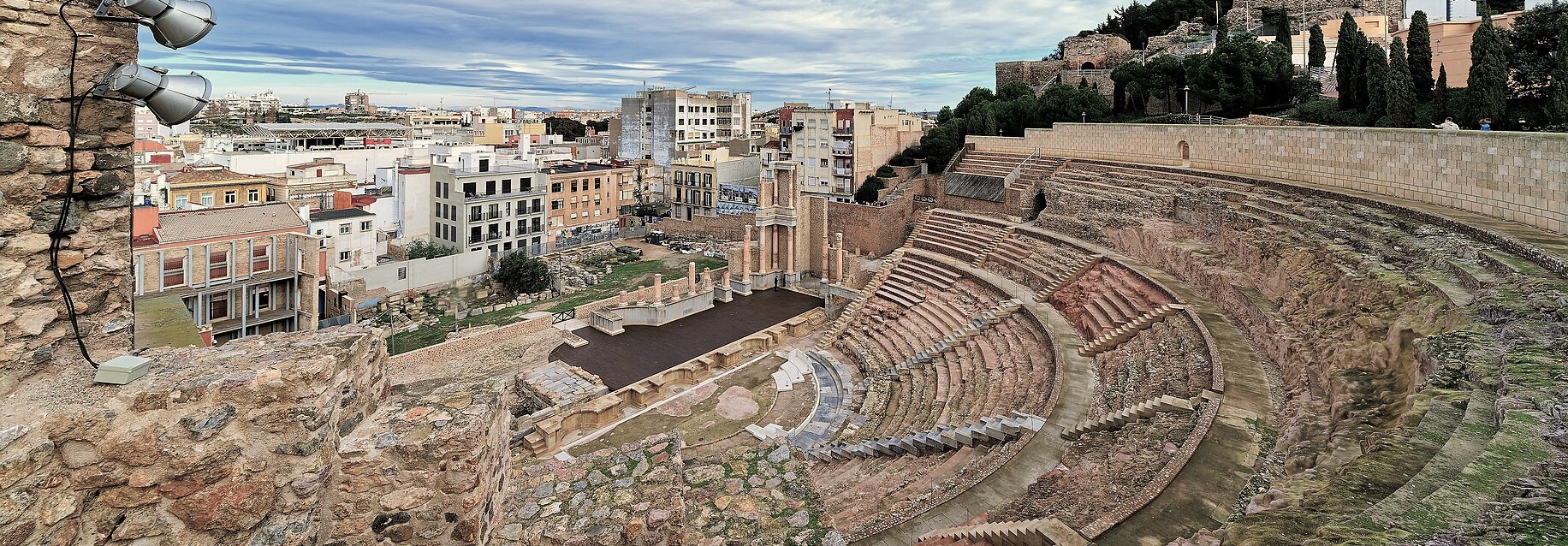Written for Timetravelrome by Michel Gybels.
Cartagena (called Carthago Nova by the Romans) was a major urban center with the usual range of civic structures to demonstrate the city’s status to the rest of the world. These included a theatre capable of accommodating around 7000 spectators, constructed between the years 5 and 1 BC. In the third century AD a market was built on the site. This in turn was destroyed by the Vandals in 425 AD.
Rediscovered in 1988, the theater has been restored so that much of it appears as it did in Roman times, including much of the seating and evocative remains of the stage building.
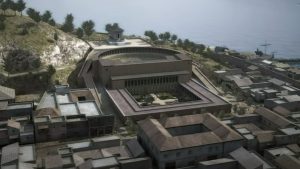
3D Reconstruction of the The theater of Cartagena. Source: regmurcia.com
History of a Discovery
The discovery and excavation of the Roman Theater in Cartagena in recent years has been one of the most surprising discoveries of archaeology of the city, as the monumentality and splendor of the theater have by far exceeded archaeologists expectations. The partial overlap of the Old Cathedral on top of the Roman theater is only the end result of a complex succession of neighborhoods and structures that have made this area a real history book.
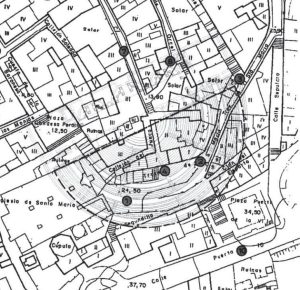
Various constructions on the site of the theater before excavations. Source: Una experiencia en la recuperación del patrimonio arqueológico el teatro de “Carthago Nova”
Indeed, since medieval times, the site of the theater was occupied by a humble but popular neighborhood – with the passage of time it had become one of the most depressed areas of the old town.
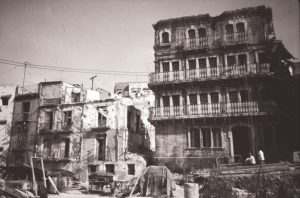
Old buildings on the site of the ancient theater prior to excavations. Source: Una experiencia en la recuperación del patrimonio arqueológico el teatro de “Carthago Nova”
The excavation works started in October 1988. This first campaign revealed a complex superimposition of structures and allowed the discovery of rich architectural elements. In the period between 1996 and 2003, the excavations were completed and the theater could be seen in all its grandeur and splendor.
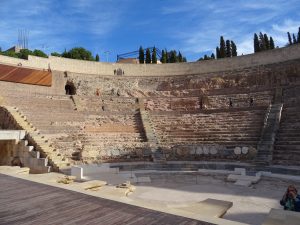
Theater of Cartagena today. Photo by Michel Gybels.
The monument and its parts
The situation of the theater in one of the highest hills of the city facilitated the construction of the cavea, which appears in its central part excavated in the rock of the mountain, while the lateral flanks are supported by vaulted galleries.
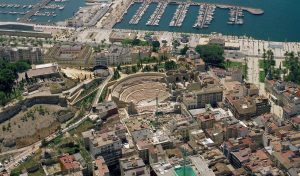
Aerial view of the theater. Source: CARM.es
The cavea with a capacity for 7,000 spectators, is divided into three horizontal sectors (moeniana), again divided by radial stairways.
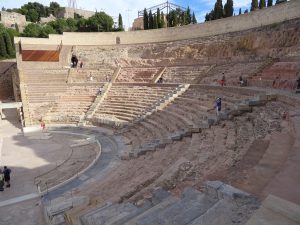
Cavea of the theater. Photo by Michel Gybels.
The main entrances were made public through two side aisles (aditus) for which two separate entrance doors lintels with dedications to Lucius Caesar, east, and probably Caius Caesar were located on the west. Both dedications, together with the consul mention designatus in the cursus of Caius one of the altars found in the pit of hyposcaenium has allowed realize the date of construction or opening of the building between 5 and 1 a. C.
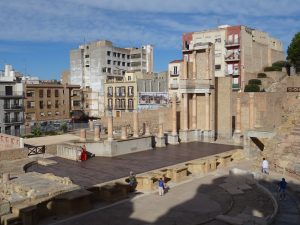
On the right one can see the entrance door to the Theater with the lintel dedicated to Lucius Caesar. Photo by Michel Gybels.
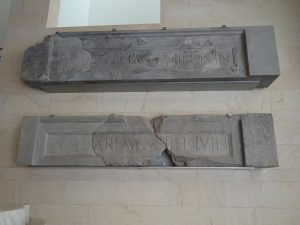
Dedicatory inscriptions to Gaius and Lucius Caesar. Photo by Michel Gybels.
These side corridors led to the orchestra – semicircular space in front of the stage or proscenium which develops with a length of 43.60 m. On the orchestra there were also three rows seats of honor (proedria) reserved to the authorities.
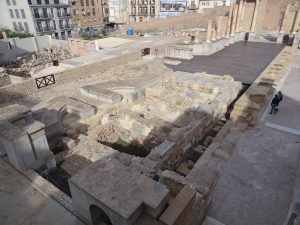
The stage of the theater. Photo by Michel Gybels.
The bases, cornices and especially capitals were adorned with rich decoration, characteristic of the Augustan era.
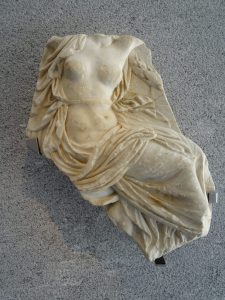
Marble relief of the Rea Silvia, mother of Romulus, found in the Theater. Photo by Michel Gybels.
Restoration
The restoration of the Roman Theater in Cartagena has resulted in a combination of techniques aiming at the replenishment of areas where the remains of the theater had disappeared completely, consolidation of some other areas, and partial re-building so that the building can be visited with comfort and also can be better understood by tourists. Importantly, all necessary measures were taken to ensure that the new additions can be dismantled without any damage to the original work, and the material impact of reconstructions was minimized.
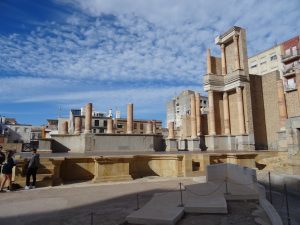
Restored elements of the scene are clearly visible. Photo by Michel Gybels.
Later history of the Theater
After the 3rd c. AD, the theater was extensively modified to serve as a market and public commercial space – a macellum. Ornamental materials were reused for the marketplace, which explains why most of the building’s fragments were found at the site of the theater itself, but in a re-used position. It is estimated that around 60% of the building’s original materials remain in situ. After the destruction of the city by the Vandals in 425, the macellum was severely damaged and probably abandoned. With the reconquest of the region by Emperor Justinian, the city was refounded as Carthago Spartaria. The ruins of the theater were once again the site of a commercial district in the 6th century AD.
Later on, in the 13th century, the St. Mary’s Cathedral was built on the site of the theater – its walls contain architectural details dating from Republican to Late Antique times, some of which can be attributed to the theater.
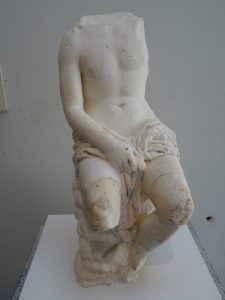
Sculpture of a lyre-playing Apollo in Cartagena’s Roman Theater Museum. Photo by Michel Gybels.
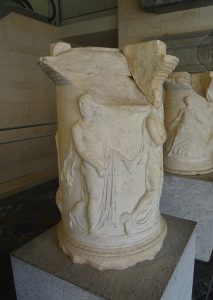
Jupiter altar – one of the three round altars dedicated to the Capitoline Triad found in situ. Photo by Michel Gybels.
Sources
Museum brochure The Roman Theatre and Museum of Cartagena
Una experiencia en la recuperación del patrimonio arqueológico el teatro de “Carthago Nova”, 2007, by Sebastián F. Ramallo Asensio
Header image: By Holger Uwe Schmitt – Own work, CC BY-SA 4.0.
